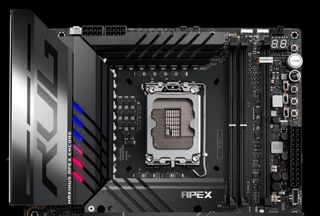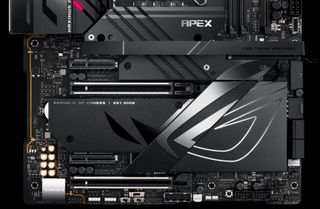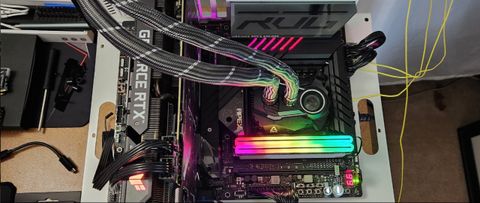Tom's Hardware Verdict
Priced at $649.99, the Asus ROG Maximus Z790 Apex Encore is an updated motherboard focused on overclocking and pushing your system to its limits. It’s a well-rounded, good-looking, and good-performing board. But unless you’re into extreme overclocking, cheaper options exist.
Pros
- +
Overclocking tools (AI and Manual)
- +
Epic VRM capability
- +
Five M.2 sockets (including one 5.0)
- +
Very high memory speeds supported
Cons
- -
PCIe 5.0 M.2 drive disables second x16 slot
- -
128GB of RAM can limit (a few) users
Why you can trust Tom's Hardware
Asus’ ROG Maximus Z790 Apex is a board dedicated to overclockers. You get one of – if not the – most powerful VRM solutions in Z790, optimized memory configuration (read: two DIMM slots instead of four), and a slew of integrated buttons and switches, dubbed the Overclocker’s Toolkit, to help push compatible processors to their limits. Priced at $649.99 on the Asus website, you not only get arguably the best made-for-overclocking motherboard with the AI Tools (DIMM Flex, Ai OC, Differential Sensing, and Condensation Detection). It’s also good at gaming and productivity, with a high-quality audio solution, ample storage options (including five M.2 sockets), and the premium ROG appearance. Overall, it’s a well-rounded board that will do well in almost any situation.
While this board can do everything, if overclocking to the CPU limits isn’t something you’ll do, there are plenty of other Raptor Lake refresh boards up the product stack and below. If you need 14th-gen support out of the box, there’s the Z790 Dark Hero ($649.99), the Z790 Formula ($749.99), our Z790 Apex Encore, and some mid-range offerings like the ROG Strix Z790-E Gaming Wi-Fi II ($499.99) and Z790-F Gaming Wi-Fi II ($429.99). None of the MicroATX or ITX-size boards seem to get updates. However, several have the BIOS Flashback feature and could already be using a BIOS with support for the new processors.
The Z790 Apex Encore performance was average to above average in most tests, just like the Z790 Formula we recently reviewed. The increased power limits/duration let the processor run free (power-wise) for a time before the system limits the processor to around 250W. You’re usually limited to what your cooling system allows, anyway.
Below, we’ll dig into the details of the board and see how it performs against other refreshed Z790 motherboards. While it won’t make the best motherboards list, this board is still easy to recommend for the hardcore overclocker, especially those planning sub-ambient cooling methods. But before we get into those details, we’ll start by listing the specifications from Asus.
Specifications: Asus ROG Maximus Z790 Apex Encore
| Socket | LGA1700 |
| Chipset | Z790 |
| Form Factor | ATX |
| Voltage Regulator | 26 Phase (24x 105A SPS MOSFETs for Vcore) |
| Video Ports | ✗ |
| USB Ports | (1) USB 3.2 Gen 2x2 (20 Gbps) Type-C (5) USB 3.2 Gen 2 (10 Gbps) (4) USB 3.2 Gen 1 (5 Gbps) |
| Network Jacks | (1) 5 GbE |
| Audio Jacks | (5) Analog + SPDIF |
| Legacy Ports/Jacks | (2) PS/2 ports for mouse/keyboard |
| Other Ports/Jack | ✗ |
| PCIe x16 | (2) v5.0 (x16, x8/x8) |
| PCIe x8 | ✗ |
| PCIe x4 | (2) v4.0 (x4) |
| PCIe x1 | ✗ |
| DIMM Slots | (2) DDR5 8400+(OC), 128GB Capacity |
| M.2 Sockets | (1) PCIe 5.0 x4 (128 Gbps) / PCIe (up to 110mm) (2) PCIe 4.0 x4 (64 Gbps) / PCIe (up to 80mm) (2) PCIe 4.0 x4 (64 Gbps) / PCIe (up to 80mm) - via ROG DIMM.2 Supports RAID 0/1/5/10 |
| SATA Ports | (4) SATA3 6 Gbps (Supports RAID 0/1/5/10) |
| USB Headers | (1) USB v3.2 Gen 2x2, Type-C (20 Gbps, 60W PD/QC4+) (2) USB 3.2 Gen 1 (5 Gbps) (2) USB v2.0 (480 Mbps) |
| Fan/Pump Headers | (8) 4-Pin (CPU, CPU Opt, AIO Pump, Chassis, Full speed, extra flow) |
| RGB Headers | (3) aRGB (3-pin) (1) RGB (4-pin) (1) 80 Light Bar |
| Diagnostics Panel | (1) Q-Code (1) Q-LEDs |
| Internal Button/Switch | Start, Flex, and Retry buttons, Alternate PCIe mode switch |
| SATA Controllers | ✗ |
| Ethernet Controller(s) | (1) Intel 2.5GbE (5 GbE) |
| Wi-Fi / Bluetooth | Intel Wi-Fi 7 (2x2 be, 2.4/5/6 GHz, 320 MHz, BT 5.4) |
| USB Controllers | ASMedia ASM1074 |
| HD Audio Codec | Realtek ALC4080 |
| DDL/DTS | ✗ / DTS: Sound Unbound |
| Warranty | 3 Years |
Inside the Box of the Asus ROG Maximus Z790 Apex Encore
Along with the motherboard, Asus includes many accessories to help get you started. You get the basics, plus a DDR5 fan holder, and more. Below is a complete list of the included accessories.
- ROG DIMM.2 with Heatsink
- M.2 pad for ROG DIMM.2
- (2) M.2 screw package for ROG DIMM.2
- Thermal pad for M.2
- ROG Memory Fan Kit
- ASUS WiFi Q-Antenna
- Q-connector
- ROG VIP card
- (3) M.2 Q-Latch packages for M.2 backplate
- (3) M.2 backplate Rubber Packages
- USB drive with utilities and drivers
- Quick start guide
Design of the Z790 Apex Encore



The Z790 Apex Encore’s appearance oozes premium ROG vibes, with black-on-black, oversized VRM heatsinks and tastefully done accents. The ROG symbol on the M.2 and chipset heatsink is unique, with the three different ‘finishes’ to make the whole. But if you don’t like the look, it will be covered by your video card anyway if it’s installed directly in the top slot, anyway. This standard-size ATX board may not have all of the shrouds similarly (or more expensive) priced boards do, but it’s made for overclocking, and shrouds can get in the way.
For those who want RGB lighting, you’re in luck, as just under the left heatsink is a RGB lighting area that glows through the base. It’s not terribly bright, but the colors are saturated, and it looks good. Either your BIOS or the Aura RGB application in the Armoury Crate software controls the patterns you see.

At the top of the board, in the left corner, we’re greeted by the two Dual Procool II 8-pin EPS connectors (one required) to power the processor. Surrounding them are two heatpipe-connected VRM heatsinks cooling the VRM bits below. On the left is the sole RGB element shining through the miter-cut heatsink. On top are the ROG letters and the board name. To the right, the socket area is clean using the flat (possibly Tantalum POSCAP) capacitors in this area, ready for sub-ambient insulation.
Just past this, we run into the two DRAM slots, reinforced with Asus’s Safe DIMM design. At the time of this writing, the website lists support up to 92GB. However, it actually supports 128GB, as this page wasn’t updated after the March announcement of increased capacity. Memory speeds are listed as incredibly fast to DDR5-8400 - one of the fastest on the Z790 platform. But, like any board, your mileage may vary. To push those speeds, pray your CPU’s integrated memory controller (IMC) can handle it as, currently, a tiny percentage can. The Apex Encore also comes with the ROG Memory Fan Kit designed to keep the warmer running (particularly when overclocked) DDR5 memory in its optimal temperature range.
To the right is Asus’s unique DIMM.2 slot, designed to be used with the included DIMM.2 add-in card for additional M.2 storage. The ROG DIMM.2 card supports two PCIe 4.0 x4 modules up to 80mm, adding to the three M.2 sockets in their more traditional locations on the motherboard.
Above these slots on the board's top edge are two (of seven) 4-pin fan/pump headers. All headers support PWM and DC-controlled devices with the CPU and Chassis fans, each Q-Fan controlled. The FS and AIO headers all output up to 12W, while the W_PUMP+ is a whopping 36W - plenty for most aftermarket watercooling pumps. The 3-pin EF_FAN header is used with the ROG Memory Fan Kit.
Also above the DIMM slots on the top edge are two RGB headers - in this case, two (of three) 3-pin ARGB headers. Along the bottom edge, you’ll find another ARGB header and another 4-pin RGB header. Control over the integrated RGB feature and any devices attached to the headers is handled through the Aura RGB section in the BIOS or the Aura application in the Armoury Crate software.
Below these is a strip of seven ‘dummy’ LEDs (on or off). The first four on the left are your Q-LEDs. These LEDs, CPU/DRAM/VGA/Boot, light up during the POST. And if a problem arises, the offending area’s LED remains lit, showing users, generically, where the problem lies. When used with the 2-character Q-Code display below, these should help you better understand what went wrong. The three LEDs on the right, labeled CPU, DRAM, or PCIe, are part of the Condensation Detection for the extreme overclocker. When the sensors detect moisture in these areas, the corresponding LED remains lit, just like the Q-LEDs.
Moving down the right edge, we run into several buttons, switches, and a voltage read point area. There’s quite a bit of functionality here, but it’s most useful for those pushing the envelope using sub-ambient cooling methods. The first items we run into is the small Safe boot button below the large Start and Flex Key buttons, and a set of three switches for the Overclocker, including Pause and Slow Mode (the third is reserved for Asus). Also, for the hardcore overclocker, the BCLK +/- buttons to adjust BCLK on the fly, along with a retry button. The strip of dots along the edge is the ProbeIt section that allows users to connect a multimeter to read the voltages off several different areas. Last but not least for the hardcore overclocker is the LN2 mode jumper. Enabling this remedies the cold-boot bug during POST. Below that, we run into the standard 24-pin ATX power connector and, finally, the front panel USB 3.2 Gen 2x2 (20 Gbps) Type-C connector.

Power delivery on the Z790 Apex Encore consists of 26 phases, with 24 dedicated to Vcore. Power flows from the EPS connector(s) onto a 20-channel Renesas RAA229131 PWM controller. From there, it moves to the 24x 105A Renesas RAA22010540 SPS MOSFETs for the processor. The 2,520A available to the processor is one of the most we’ve seen on Z790, and will handle overclocked flagship-class processors like our Intel i9-14900K, even pushing the limits with sub-ambient cooling. You’ll run out of cooling capacity before the power delivery gets in the way. There’s nothing to worry about here!

On the bottom half of the board, we’ll start with the audio section on the left, mostly hidden under shrouds and heatsinks. Asus uses the premium Realtek ALC4080 codec, but unlike the Formula, it does not come with an integrated DAC. I like Asus’ choice to go with the modern audio codec. It’s not a flagship-class solution, but it still has high-quality audio that’s perfect for gaming or other uses.
In the middle of the board, we’ll start with the M.2 sockets. In this case, three are on the board, along with the two from the DIMM.2 module. Onboard, all integrated sockets support up to 80mm modules. Both M.2_1 and M.2_2 connect through the processor, while the top M.2_1 runs up to PCIe 5.0 x4 speeds (128 Gbps), while the lower slot runs up to PCIe 4.0 x4 (64 Gbps). M.2_3 connects through the chipset (as does the DIMM.2 device) and runs up to PCIe 4.0 x4 and SATA modes. If you want additional speed or redundancy, the Z790 Formula supports RAID0/1/5/10 modes for NVMe drives. Just note that when you use the PCIe 5.0-capable M.2, the second full-length PCIe slot is disabled, and the primary slot runs at PCIe 5.0 x8.
For PCIe slots, there are a total of four. Two full-length slots connect through the CPU, and two x4 size through the chipset, which is an update from the Z790 Apex. The top full-length slot, primary for graphics cards, uses Asus’ Q-slot reinforcement and sports the GPU-swapping-friendly Q-Release button. The bottom full-length reinforced slot connects through the CPU and runs up to PCIe 5.0 x8 speeds. But as noted above, you’ll lose this slot when M.2_1 is populated. With bandwidth the same between 5.0 x8 and 4.0 x16, you won’t lose performance on existing graphics cards. Finally, the two x4 slots above and below the full-length slots connect through the chipset with PCIe 4.0 x4 lanes available.
Moving to the edge of the board, a lot is happening here, too. You have the standard SATA ports (4) and front panel USB (3.2 Gen 1, 5 Gbps), but you also have an 8-pin PCIe power connector to support the quick charging (QC4+) capability. Just below is a fan header and a lightbar header for RGBs.
Across the bottom of the board are several exposed headers. You’ll find the usual, like additional USB ports, RGB headers, a header for temperature and water flow probes, and a BIOS switch, and a switch to adjust PCIe generations on the fly. Below is a complete list from left to right.
- Front panel audio
- 4-pin RGB header
- 3-pin ARGB headers
- (3) System Fan headers
- Reserved and V_Latch switches
- PCIe Alt Mode switch
- Thunderbolt header
- USB 3.2 gen 1 (5 Gbps) connector
- Water Flow in/out headers
- (2) USB 2.0 headers
- 2-pin temperature sensor
- Front panel header

The Rear IO plate on the Z790 Apex Encore comes preinstalled, as you’d expect from high-end boards these days. It uses a black background with white labels on the ports for easy reading. There are a total of 10 USB ports: One USB 3.2 Gen 2x2 (20 Gbps) Type-C, Five USB 3.2 Gen 2 (10 Gbps) ports in red, and five USB 3.2 Gen 1 (5 Gbps) ports in blue. On the left are the BIOS Flashback and CMOS reset buttons, next to legacy PS/2 ports that are especially useful for extreme overclocking. For networking, you have the 2.5 GbE port, along with the Wi-Fi 7 Q-Connector. Lastly, the audio stack comprises five 3.5mm analog plugs and an SPDIF output.
MORE: Best Motherboards
MORE: How To Choose A Motherboard
MORE: All Motherboard Content

Joe Shields is a Freelance writer for Tom’s Hardware US. He reviews motherboards.

Microsoft is switching RAM speed units in Task Manager — finally moving to the more technically correct MT/s

Pre-Memorial Day Sales 2024: Save on gaming laptops, CPUs, monitors and more

Lenovo ThinkPad P1 Gen 7 is the world's first laptop to sport LPCAMM2 memory — more compact, higher performance, lower power
-
Order 66 1. $650 is insane for a motherboard. 2. Overclocking isn't nearly as beneficial as it used to be. 3. There is very little point to this motherboard for ~99% of people.Reply -
CmdrShepard Reply
It's hard to disagree with your 3rd point, however point 2 is up for debate because "overclocking" also means the ability to tweak your system to optimal power / performance ratio (you can't do that with non-O/C boards).Order 66 said:1. $650 is insane for a motherboard. 2. Overclocking isn't nearly as beneficial as it used to be. 3. There is very little point to this motherboard for ~99% of people.
As for the price it's on the higher end, but admittedly the board has 26-phase power delivery and ticks "new standards" boxes such as Wi-Fi 7, Bluetooth 5.4 and PCI-E 5.0 M.2.
I use a HEDT / workstation board (unlocked Xeon on W790 board with O/C capability) which nowadays start at $750 and IMO are much better value for money than this consumer stuff but that's not for everyone either and considering those prices this one is still relatively "cheap". -
thestryker Reply
Unlike most $500+ motherboards you're actually getting a lot for your money here from a useful perspective. So yes it's expensive, but you're also not throwing your money away for it to look cool and have a lot of connectivity. The only boards which can touch this memory wise are the Z790 Tachyon and Tachyon X which have poor availability and cost more.Order 66 said:1. $650 is insane for a motherboard. 2. Overclocking isn't nearly as beneficial as it used to be. 3. There is very little point to this motherboard for ~99% of people.
It's a shame that more manufacturers haven't put out more 2 DIMM variants because as you say most people don't need the majority of features at play here, but could benefit from some. -
Amdlova Looking at power numbers :) the ryzen 7950x power draw is my entire machine with sound and monitor when gaming...Reply
The 14900k is two times...
The h670 I have cost only 105 bucks... that 650 don't justified the price :)
Insanely high price for a dead platform :) -
GettnBetter My experience with the Encore was good but, I was unable to find or get Sonic Studio to work. There's no drivers available that support any audio enhancements for this board, the equalizer is completely missing as an available analog audio option. It's not part of Armory Crate or MoKiChU's updated drivers and going backwards with the legacy USB Audio drivers didn't work either. How did you determine this board supports Sonic Studio?Reply
